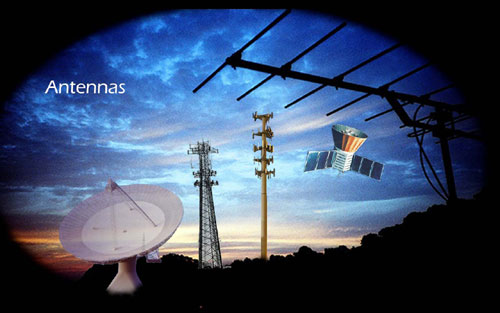TECHNOLOGY FOCUS
Plasma antennas are not just another antenna. They have applications in telecommunications, 5G, RADAR, GPS, plasma antennas operating at 222 nm for the inactivation of SARS-CoV-2 and other viruses that cause pandemics, plasma antennas operating at 95 GHz to non-lethally stop shooters, atmospheric plasma antennas operating from aircraft to create ion beams that cause raindrop coalescence and hence rain to mitigate the world wide drought problem and to extinguish forest fires. Plasma antenna coils in MRI machines give better imaging than standard MRI machines that use metal coils. Plasma gradient coils used in an MRI machine can eliminate the banging noise that many people do not like. Plasma coils used in an MRI/ PET machine can make it easier to find tumors. Since x-rays and gamma rays do not get attenuated through plasma coils whereas they do through metal coils.


COURSE CONTENT
The course content will consist of dipole plasma antennas, smart plasma antennas, satellite plasma antennas, plasma reflector antennas, reduction of co-site interference, radiation patterns, smart plasma antenna, high power plasma antennas, reflector plasma antennas, pulsing plasma antennas, and how to make a basic plasma antenna.
WHO SHOULD ATTEND
The people who should attend should have a BS degree or European Diploma in physics or electrical engineering. No background in antennas or plasma physics is required. Basic electromagnetics, antenna theory, and plasma physics will be taught.

Day 1
1. Basic Antenna Theory
Dipole antennas, helical antennas, spiral antennas, reflector antennas.
Antenna radiation patterns. Beamwidths, bandwidths, directivity, gain, efficiency, Friis Transmission Line Equation.
Day 2
2. Plasma Physics for Plasma Antennas
2.1 Mathematical Models of Plasma Physics
2.2 Man-Made Plasmas and Some Applications
2.3 Basic Physics of Reflection and Transmission from a Plasma Slab Barrier
2.4 Experiments of Scattering Off of a Plasma Cylinder
2.5 Governing Plasma Fluid Equations for Applications to Plasma Antennas
2.6 Incident Signal on a Cylindrical Surface
2.7 Fourier Expansion of the Plasma Antenna Current Density
2.8 Plasma Antenna Poynting Vector
2.9 Some Finite Element Solution Techniques for Plasma Antennas
2.10 Barrier Penetration
2.11 Calculation of Scaling Function
3 Fundamental Plasma Antenna Theory
3.1 Net Radiated Power from a Center-Fed Dipole Plasma Antenna 31
3.2 Reconfigurable Impedance of a Plasma Antenna 33
3.3 Thermal Noise in Plasma Antennas 34 References 36
Day 3
4 Building a Basic Plasma Antenna
4.1 Introduction
4.2 Electrical Safety Warning
4.3 Building a Basic Plasma Antenna. Design I
4.4 Building a Basic Plasma Antenna. Design II
4.5 Materials
4.6 Building a Basic Plasma Antenna: Design III
5. Plasma Antenna Nesting, Stacking Plasma Antenna Arrays, and Reduction of Cosite Interference
5.1 Introduction
5.2 Physics of Reflection and Transmission of Electromagnetic Waves Through Plasma
5.3 Nested Plasma Antenna Concept
5.3.1 Example of Nested Plasma Antennas
5.3.2 Schematic Conceptual Design of Stacked Plasma Antenna Arrays
5.4 Cosite Interference Reduction Using Plasma Antennas
5.5 Plasma Antenna Nesting Experiments
6. Plasma Antenna Windowing: Foundation of the Smart Plasma Antenna Design
6.1 Introduction
6.2 The Smart Plasma Antenna Design: The Windowing Concept
6.2.1 Multiband Plasma Antennas Concept
6.2.2 Multiband and Multilobe or Both Plasma Antennas Concept
6.3 Theoretical Analysis with Numerical Results of Plasma Windows
6.3.1 Geometric Construction
6.3.2 Electromagnetic Boundary Value Problem
6.3.3 Partial Wave Expansion: Addition Theorem for Hankel Functions
6.3.4 Setting Up the Matrix Problem
6.3.5 Exact Solution for the Scattered Fields
6.3.6 Far-Field Radiation Pattern
6.3.7 Eight-Lobe Radiation Patterns for the Plasma Antenna Windowing Device
6.3.8 Dissipation in the Plasma Window Structure: Energy Conservation in an Open Resonant Cavity
7. Smart Plasma Antennas
7.1 Introduction
7.2 Smart Antennas
7.3 Early Design and Experimental Work for the Smart Plasma Antenna
7.4 Microcontroller for the Smart Plasma Antenna
7.5 Commercial Smart Plasma Antenna Prototype
7.6 Reconfigurable Bandwidth of the Smart Plasma Antenna
7.7 Effect of Polarization on Plasma Tubes in the Smart Plasma Antenna
7.8 Generation of Dense Plasmas at Low Average Power Input by Power Pulsing: An Energy-Efficient Technique to Obtain High-Frequency Plasma Antennas
7.9 Fabry-Perot Resonator for Faster Operation of the Smart Plasma Antenna
7.9.1 Mathematical Model for a Plasma Fabry-Perot Cavity
7.9.2 Slab Plasma
7.9.3 Cylindrical Plasma
7.10 Speculative Applications of the Smart Plasma Antenna in Wireless Technologies
7.10.1 Introduction
7.10.2 GPS-Aided and GPS-Free Positioning of Plasma Antennas
7.10.3 Multihop Meshed Wireless Distribution Network Architecture of Smart Plasma Antennas
7.10.4 Reconfigurable Beamwidth and Lobe Number
7.10.5 Adaptive Directionality of Smart Plasma Antennas.
7.10.6 Cell Tower Setting
Dr. Anderson has published texts that are a recommended reference. The references are not required for this course.
Plasma Antennas, Second Edition, (Artech House, 2010) ISBN: 9781630817503
My original book titled “Plasma Antennas”, (Artech House, 2010) ISBN: 78-1-60807-143-2

